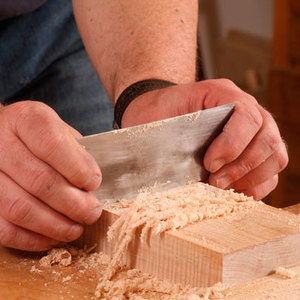Making Sense of Sandpaper
Knowing how it works is the first step in choosing the right abrasive
Synopsis: As Strother Purdy of Fine Woodworking learned, you can’t go right buying cheap sandpaper, but it’s still easy to go wrong with the best sandpaper that’s available. The key to choosing the right sandpaper is knowing how different kinds of sandpaper work. In this article, he explains sandpaper’s components and how they contribute to the performance, determining how quickly it works, how long it lasts, and how smooth the result will be. Sandpaper is a cutting tool, on a small scale. He explains how it’s made, how to sand efficiently with different grits and in different directions. He tells how to choose from among the four abrasive minerals, and he shares points about grading scales. He talks about backings and bonds and why they are important. Separate side notes on each mineral type help clarify the differences, and the article includes an abrasive grading system chart.
Years ago at a garage sale, I bought a pile of no-name sandpaper for just pennies a sheet. I got it home. I sanded with it, but nothing came off the wood. Sanding harder, the grit came off the paper. It didn’t even burn very well in my wood stove. Sanding is necessary drudge work, improved only by spending less time doing it. As I learned, you can’t go right buying cheap stuff, but it’s still easy to go wrong with the best sandpaper that’s available. Not long ago, for example, I tried to take the finish off some maple flooring. Even though I was armed with premiumgrade, 50-grit aluminum-oxide belts, the work took far too long. It wasn’t that the belts were bad. I was simply using the wrong abrasive for the job. A 36-grit ceramic belt would have cut my sanding time substantially.
The key to choosing the right sandpaper is knowing how the many different kinds of sandpaper work. Each component, not just the grit, contributes to the sandpaper’s performance, determining how quickly it works, how long it lasts and how smooth the results will be. If you know how the components work together, you’ll be able to choose your sandpaper wisely, and use it efficiently. Then you won’t waste time sanding or end up burning the stuff in your wood stove.
Sandpaper is a cutting tool
What sandpaper does to wood is really no different from what a saw, a plane or a chisel does. They all have sharp points or edges that cut wood fibers. Sandpaper’s cutting is simply on a much smaller scale. The only substantial difference between sandpaper and other cutting tools is that sandpaper can’t be sharpened.
Look at sandpaper up close, and you’ll see that the sharp tips of the abrasive grains look like small, irregularly shaped sawteeth (see the drawing on p. 67). The grains are supported by a cloth or paper backing and two adhesive bonds, much the way that sawteeth are supported by the sawblade. As sandpaper is pushed across wood, the abrasive grains dig into the surface and cut out minute shavings, which are called swarf in industry jargon. To the naked eye, these shavings look like fine dust. Magnified, they look like the shavings produced by saws or other cutting tools (see the inset photo at right).
Even the spaces between the abrasive grains serve an important role. They work the way gullets on sawblades do, giving the shavings a place to go. This is why sandpaper designed for wood has what’s called an open coat, where only 40% to 70% of the backing is covered with abrasive. The spaces in an open coat are hard to see in fine grits but are very obvious in coarse grades.
From Fine Woodworking #125
For the full article, download the PDF below:
Fine Woodworking Recommended Products

Bumblechutes Bee’Nooba Wax

Bahco 6-Inch Card Scraper

Diablo ‘SandNet’ Sanding Discs




















Log in or create an account to post a comment.
Sign up Log in